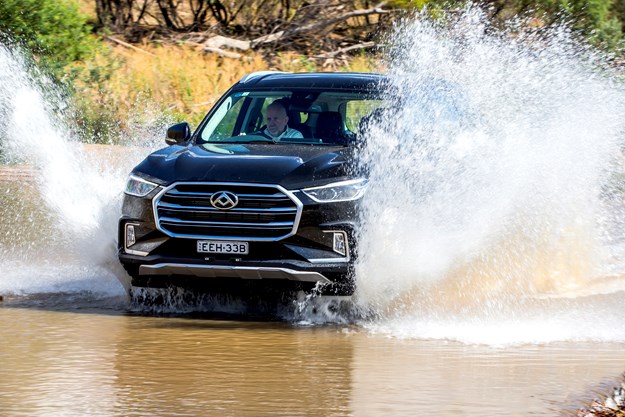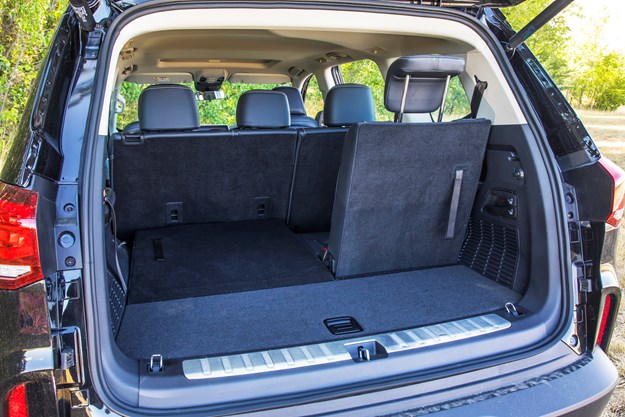Fancy a Prado-sized 4x4 wagon and can’t afford the freight? Try this LDV D90 for size
What you see here is an LDV D90 4×4 wagon, complete with low-range gearing, separate chassis and a live axle at the rear. A proper 4×4 if you like, at least with those attributes.
LDV is part of SAIC Motor, one of the four large state-owned carmakers in China. In 2018, SAIC sold more than 6.9 million vehicles, so no small fry.
Aside from the D90 4×4 wagon, LDV also sells the T60 4×4 dual-cab ute, one variant of which – the TrailRider – is tweaked locally by Walkinshaw Performance. LDV also offers single-cab T60 utes in both 4×4 and 4×2, as well as delivery/service vans and a people mover.
This D90, the Executive, is the only 4×4 variant in the D90 range (the others are rear wheel drive) and while you can think of it as a budget alternative to a Prado, there is one difference: at this stage it only comes with petrol power. But that doesn’t mean we won’t see a diesel down the track, given the 2.8-litre four-cylinder diesel from the T60 ute – built under licence from VM Motori and from the same engine family as the 2.8 diesel in Holden’s Colorado and Trailblazer – should slot straight in.
POWERTRAIN AND PERFORMANCE
In the meantime, the petrol engine is in many ways already ahead of the game. Certainly it’s a more forward-thinking design than the last petrol engine to be seen in Prado, and perhaps more like the next-generation petrol engine yet to the seen in Prado, even if that will be a petrol-electric hybrid.
The engine is question is a relatively small capacity 2.0-litre four cylinder, but with the help of a twin-scroll turbocharger, direction-injection, variable timing on both cams and otherwise modern twin-cam 16-valve and short-stroke architecture it manages a healthy 165kW. Better still is the fact its maximum torque – 350Nm – is on tap by a relatively low 2,500rpm and doesn’t start to drop off until 3,500rpm. By way of comparison, the last petrol engine in the Prado (a 4.0-litre V6) produced 381Nm but had to rev all the way to 4,400rpm to do so.
On the road, the D90’s engine is relaxed and generally effortless in general driving and decently urgent when asked to give its all. The final drive gearing is not overly tall (around 50km/h/1,000rpm), which also helps with the general responsiveness. All the while it’s smooth and generally refined; although, perhaps not as quiet as it could be.
For its part the six-speed automatic works reasonably well but is doughy in the standard ‘Auto’ mode in more demanding driving conditions, a problem thankfully solved by switching to the far sharper ‘Sport’ mode. These modes, as well as an even softer-responding ‘Eco’ mode, are on a dial on the centre console, which also has the various off-road modes (see below).
ON ROAD RIDE AND HANDLING
If the D90’s engine is a pleasant surprise, so too is its on-road handling and steering. It may not be the last word in dynamic excellence, but the steering is reasonably sharp on centre and offers a positive feel on turn-in, no doubt helped by the 19-inch wheels and the relatively low-profile Continental high-speed road tyres.
The suspension offers generally good control and a comfortable ride; although, it can be a bit sharp on bad roads at low speeds, perhaps also a result of the low-profile 255/55R19s. The good news is that 18s, or even 17s, and therefore taller tyres, can be fitted, as there’s no problem with the smaller wheels fouling the brakes.
OFF-ROAD
The D90 has what’s called an ‘All-Terrain Four Wheel Drive System’ that has modes for ‘Snow’, ‘Mud’, ‘Sand’ and ‘Rock’. The ‘Snow’ mode uses auto proportioning of the ‘smart’ centre diff and works surprisingly well on gravel and unsealed roads. Land Rover, with its Terrain Response system, which pioneered this technology, combines ‘Grass-Gravel-Snow’ in one mode, so this is probably no surprise.
Selecting either the ‘Sand’ or ‘Mud’ modes feels to lock the centre diff, while selecting the ‘Rock’ mode additionally engages low range and is also the only way to engage low range, as there isn’t a separate low-range switch. This probably needs a re-think (see 4×4 Alternatives breakout) to allow you to select either ‘Sand’ or ‘Mud’ and low range.
You can, of course, always use the ‘Rock’ mode for heavy sand or mud conditions, and it seems to work okay, but going on our experience with Land Rover’s excellent Terrain Response system, powertrain and chassis electronics optimised for slow rock climbing aren’t ideal for sand or mud, and visa versa.
This oversight aside, the D90 is handy enough off-road thanks largely to good wheel travel, especially at the back. There’s also a driver-switched rear locker. More ground clearance would be handy, but even just getting rid of the 255/55R19s for a taller tyre and wheel package based on 17s or 18s would help. The engine air intake via the inner guard is a bonus, as is the solid front recovery hook hidden beneath a plastic panel. At the rear there’s a screw-in towing hook, so not what you ideally want for recovery but at least it looks solid enough.
CABIN, ACCOMMODATION AND SAFETY
Climb into the D90’s cabin and you can’t help but be impressed by the space up front, in the middle row and in the third-row seats. With the third-row up there’s even some luggage space left, which is a real luxury indeed.
The driver’s seat is good without being great, but does come with electric lumber adjustment. The driver also benefits from tilt-and-reach steering wheel adjustment. The second-row seat adjusts fore and aft, so you can tailor the second- and third-row legroom depending on the occupants; although, even with the second row right back the third-row legroom is still small-adult friendly. The second row can also be lowered via two levers in the rear cargo area, making it easier to load long objects from the rear of the car. A cargo net and cargo blind are also standard.
The fit and finish and the leather seat trim give very much an upmarket feel, but the presentation is quite busy, which won’t please everyone. Myriad dings, dongs and chimes for everything you turn on or off, or adjust, can also be annoying and is a pretty typical Chinese-car experience.
The D90 is loaded with safety kit (see ‘What you Get’ breakout) and when tested in 2017 gained five stars in the ANCAP test. The only issue here is the automatic (radar-controlled) cruise control, which is clunky and erratic in the way it applies the brakes, and it’s probably the single worst aspect of the entire car. And unfortunately there’s no manual cruise control fitted.
PRACTICALITIES
The 630kg payload is respectable, but at 2,000kg the tow rating is very modest. And while the spare tyre is full-size it doesn’t match the road wheels, being a steel wheel carrying a 245/65R17 tyre.
Being a turbocharged engine, standard grade (91RON) fuel probably won’t cut it and, while the owner’s book says 92 octane, it doesn’t specify which of the many octane standards used around the world that relates to. For safety sake we ran the D90 on 95 RON Premium, which worked without an issue. Test fuel use was 13.2L/100km, which isn’t bad at all given the D90 is a big and relatively heavy 4×4 wagon. Five-year/130,000km warranty and roadside assistance is reassuring, as is the 10-year ‘no rust’ warranty on the body.
At $43,990 (or $41,790 for ABN title holders) driveaway, the D90 definitely offers value for money given that equates to a list price of less than $40K. For that you get heaps of kit, a big, well-finished cabin, respectable on-road performance and handling, and equally respectable off-road performance. It’s not perfect, but aside from the radar cruise control there’s nothing that deserves serious criticism.
SPECIFICATIONS
LDV D90 EXECUTIVE 4WD:
Engine: 2.0-litre 4cyl turbo petrol
Max power: 165kW @ 5,300rpm
Max torque: 350Nm @ 2,500–3,500rpm
Gearbox: Six-speed automatic
4X4 System: Dual range/on-demand
Crawl ratio: 41.3:1
Construction: Separate-chassis
Front suspension: Independent/coil springs
Rear suspension: Live axle/coil springs
Wheel/tyre spec: 255/55R19 111 V
Kerb weight: 2,330kg
Payload: 630kg
GVM: 2,960kg
Towing capacity: 2,000kg
GCM: 4,960kg
Fuel tank capacity: 75 litres
ADR fuel claim: 10.9 litres/100km
Test fuel use: 13.2 litres/100km
Test fuel range: 518km
Price: $43,990 (driveaway)
D90 off-road specifications:
Ground clearance: 210mm
Approach angle: 28.0º
Ramp-over angle: 20.0º
Departure angle: 25.0º
Wading depth: 550mm






.JPG)
.JPG)
